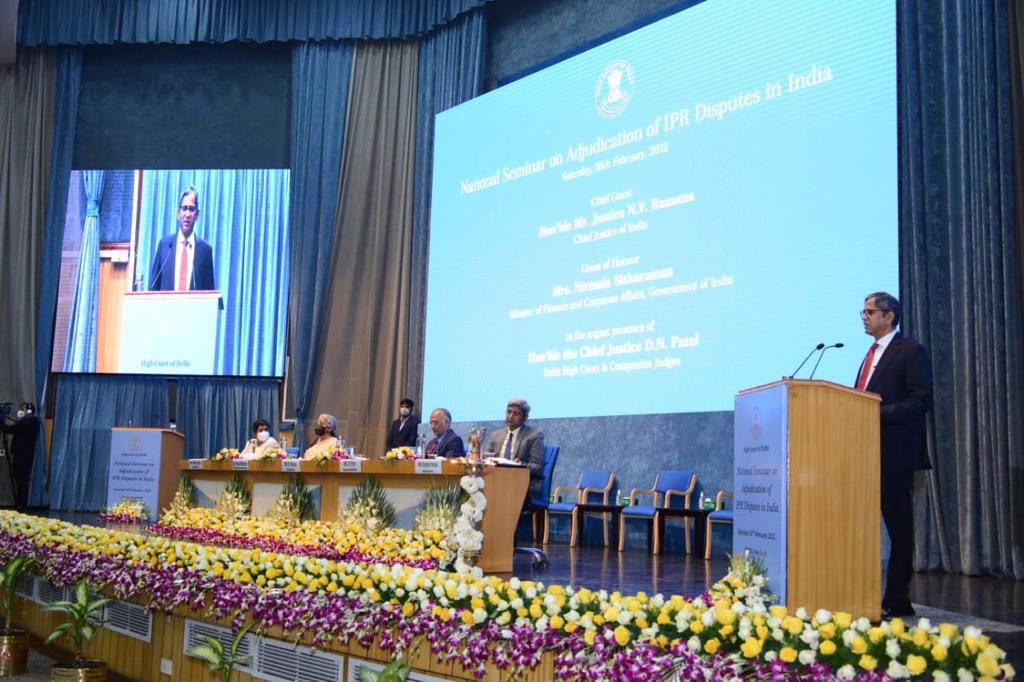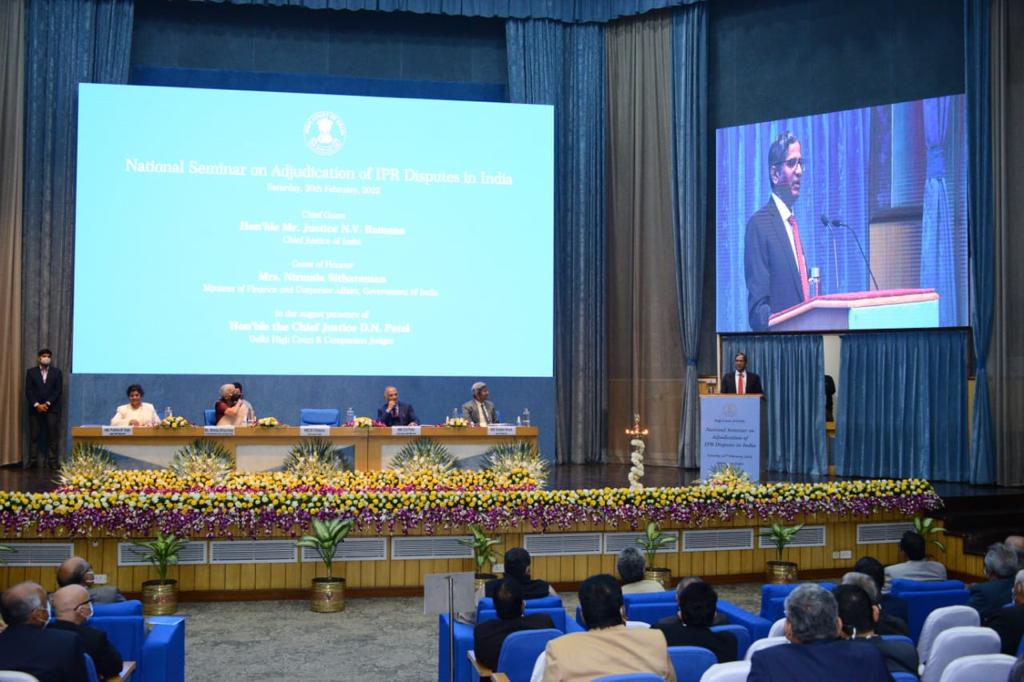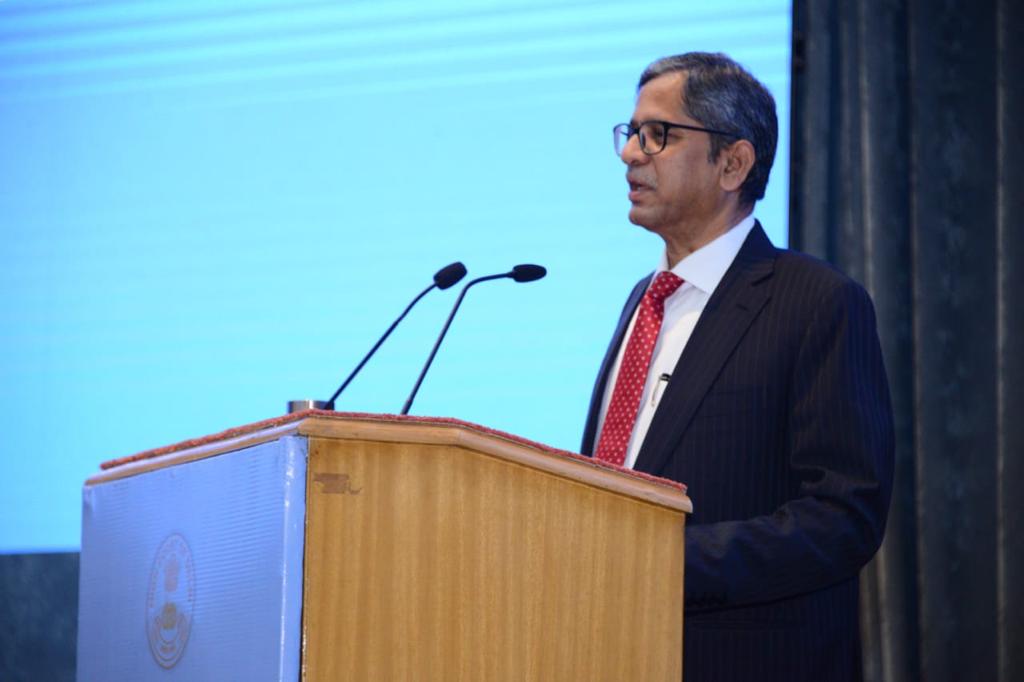Chief Justice of India N.V. Ramana on Saturday stressed on improved judicial infrastructure in the country, especially in view of the vesting of Intellectual Property Rights (IPR) jurisdiction from IPAB to the High Courts.
Addressing the national seminar on adjudication of IPR disputes in India, the CJI said judicial infrastructure needs to be improved.
“Unfortunately, we are not even meeting the basic minimum standards in this area. It has been my endeavour since assuming the office of Chief Justice of India, to put in place an institutional mechanism to co-ordinate and oversee the improvement of judicial infrastructure.”
He further said that mere allocation of funds was not enough. The challenge was to put the available resources to optimum use.
“I have been pursuing the
government for setting up of statutory authorities, both at the centre
and at the states. I have recently emphasised about the need for continuous training and upgradation of skills as one of the major challenges before the Indian judiciary,” he added.

The CJI said the vesting of IPR jurisdiction back in the High Court comes at a time when the judiciary is already overburdened with the backlog.
“However, this would not deter us from rising to the occasion and putting in place systems which may be required to deal with the new regime. It is an appropriate moment to build sufficient capacities in our High Courts, so that intellectual property litigation can be conducted efficiently and smoothly.
“It is in this context that the seminar organised today is of significant value.
“These new and additional challenges can be effectively met by strengthening the High Courts. Not only do we need to fill the existing
vacancies on an urgent basis, but there is also a need to increase the
number of judges. With better service conditions, we may be able to
attract more and more talents into our fold,” he added.
The CJI stressed on provisions for stronger enforcement and action against infringement. He suggested undertaking awareness campaigns,
especially in rural areas. There have
been a few success stories like Darjeeling tea and Chanderi silk. These
success stories need to be studied and replicated in other GIs as well.
He said with the start-ups coming up in a big way across the country driven
by innovative youth, this field of law has become more relevant than
ever before.
Coming to the judicial setup to deal with issues related to IPR a
brief background of development in law should be looked into. It is a historically known fact that prior to the 1999 Trade Marks Act, all litigation relating to intellectual property was being handled by the District Courts and the five High Courts namely Delhi, Bombay, Calcutta, Madras and Gujarat.
However, in 1999, the Intellectual
Property Appellate Board (IPAB) was created as a specialised Tribunal
for dealing with IPR cases, added Justice Ramana.
The CJI said, “When I visited Japan in 2016 to attend a conference on IPR, I was repeatedly asked by the entrepreneurs as to how investor friendly the Indian judicial system is. In fact, whenever I travel abroad, from a cross section of hosts, I keep getting similar queries. My answer has always
remained the same; that the Indian judiciary is absolutely independent
and it always treats all the parties equally and equitably.
“With the advancement of technology, we are witnessing more complex issues in litigation, be it in IPR, IT and other fields. The complexities involved demand assistance from experts and specialists in the adjudication process,” he said.
Talking about Finance Minister Nirmala Sitharaman, CJI Ramana said she was one of the most powerful Ministers, by virtue of holding the purse strings of the country. Her area of research during her student days was Trade relations within the GATT framework. Her academic research, coupled with practical experience in the ministries
of Commerce and Finance, are a great help in formulating the policies, he added.
On setting up of the Intellectual Property Division in Delhi High Court, Justice Ramana appreciated the efforts made by Justice Pratibha Singh, calling her an authority on IPR. The fact that she left her lucrative practice, is a testament to her commitment to public service, he added.
The CJI also mentioned the efforts made by Justice Sanjeev Narula, member of IPD Committee, in framing of new rules.
He said, “The Intellectual Property Division of the Delhi High Court and its functioning would hopefully serve as a model, which could be replicated.
“While protecting the interests
of today, we must not lose sight of the bigger picture. This is where a
judicial mind comes into play. While adjudicating the claims of
intellectual property rights, you must balance the contemporary claims
with the sustainable interests of the future generations,” added the CJI.
He said Intellectual property was a field of law, which protected the creativity and innovation. Its importance was also felt during the ongoing pandemic.
Innovation, and that too quick innovation, has become the order of the day. With the onset of the pandemic, vaccines and medications had to be researched, trials had to be conducted and commercial scale
manufacturing had to take place within a span of few months.
When the future generations will look back; the past two years of
pandemic will tell the story of human resilience and power of
innovation.
He said, “IPR touches every aspect of our life. From the food we eat, to the
books and movies we enjoy, to the appliances and tools we use.
“IPR is not a new chapter in Indian jurisprudence. The earlier Patent
Act of 1970 was framed with an objective; to provide a reasonable
balance between adequate and effective protection of patents on the
one hand; and technological development, public interest and specific needs of the country on the other.
“With the advent of economic liberalisation, the country’s IPR regime
has undergone a rapid transformation. This transformation was driven
by the compulsions of integrating our economy with that of the world,” he added.
As per the CJI, during the Uruguay Round of trade negotiations under GATT, the developed world pushed for mandatory inclusion of IPR in every sphere.
He said, “Considering the fact that 99 percent of the global patents were held by the developed world, any agreement for their protection was perceived as favourable to them, at the cost of developing countries.
“The inclusion of intellectual property in the agenda of trade negotiations was a bone of contention between the developed and the developing countries. For some, TRIPS was a product of bargain, while others viewed it as coercion.
“Generally speaking, the popular narrative in the third world was
that IPR was a self-serving tool of the developed world to further their
revenues from emerging foreign markets,” noted CJI Ramana.

As India was embarking on liberalisation, it hoped that the
international trade negotiations would help developing countries to
integrate with the global economy on favourable terms, he noted.
The CJI said in the absence of a level-playing field, India and other developing countries, had to
negotiate over several rounds.
Aided by domestic pressure exerted by the opposition and the civil society, we had to bargain hard before
achieving certain concessions while signing TRIPS.
Today, India’s position as the Pharma hub of the globe is largely attributable to the existing IPR regime. Several pharmaceutical Multi National Companies have been contracting Research & Development to national laboratories in India for the past two decades.
The existing framework has enabled a massive growth of pharmaceutical exports by India, with local firms building capabilities in making generic products. The lower price of generic drugs has enabled access to lifesaving
medicines for those in the developing and under-developed countries.
Indian pharmas have been producing low-cost treatments for HIV, tuberculosis, and malaria, and are the major vaccine producers of the
world. Today, India has rightfully earned the title of ‘pharmacy of the
world’.

He said, “Whenever we talk about IPR regime in India, it always reminds us
of Novartis vs Union of India. The Supreme Court stopped the practice
of the pharma industry, to extend the patent period by simply tweaking
some constituent element. This decision has helped common man, by
ensuring that lifesaving drugs are available at an affordable cost.
“The second sector I would want to concentrate on, is the impact of
IPR on agriculture. As a son of a farmer, my views can be taken to be
biased. I understand the hard work and labour involved in farming.
Agriculture is the back-bone of our country. Our history in agriculture
encompasses our ethos, culture and living. In India, the art of developing new varieties and techniques, usually gets passed on from generation to generation. Unlike western countries, agriculture is seen as a community right.
“In modern times, private companies have entered this arena in developing new varieties and high yielding plants. Huge investments in bio-technology have resulted in slow degradation of community knowledge and is replaced by private ownership. These companies
expect a certain level of protection for the variants of plants they develop.
“In order to strike a balance between innovation and concerns as such rights of farmers and food security, in line with TRIPS, India enacted the ‘Protection of Plant Varieties and Farmers Rights Act’ 2001.
“The third area which I would like to highlight is Geographical Indications. From Banarasi to Pochampally Sarees, from Darjeeling tea to Banaganapally mangoes, Tirupathi laddu to Dharwad Peda, Geographical Indications represent our tradition, heritage and
territory.
“India has around 400 registered geographical indications. However, we can observe that there is a great disparity between the States in India concerning GI registration. Though certain states are performing well others are yet to catch up. There is an
immediate need to take corrective steps to achieve the full potential of
geographical indications,” he added.
Full speech of Chief Justice of India N.V. Ramana’s speech:
IPR-26022022

